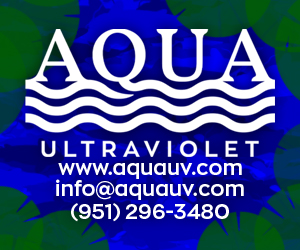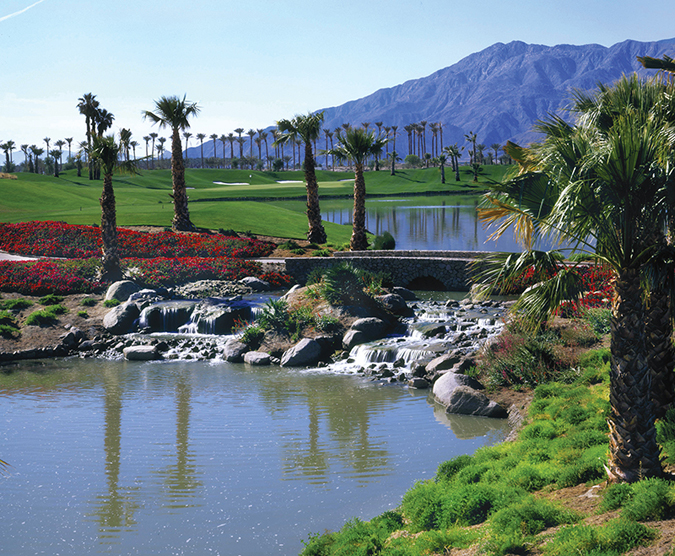
Imagine you have a golf course with 10 water features. Two are functioning perfectly, three are much harder to manage, and five may only require simple preventative measures. Usually, the tougher cases will eventually motivate golf course superintendents to seek a specialist, for every lake has its own distinctive features. Maintenance and upkeep can be quite complex, especially when managing multiple lakes.
So where does one start? In order to properly manage lakes or ponds in your golf course, one must be proficient in three areas. First, you must understand the factors that contribute to a lake’s ecological health. Next, it’s important to know the issues that will arise based on those elements. Only then can you reach a solution that is specifically aimed at the problem.
There are countless factors that could be contributing to or disrupting the balance of your lake ecosystem. First off, we can start by identifying the determinants of lake health. These include nutrients, biota, age, environmental factors and dissolved oxygen.Nutrient Sources
Aquatic nutrient sources can include sediment and vegetation in the lake and runoff water from surrounding turf areas. In general, excess nutrients can be sourced from agriculture, sewage, chemical discharge and homeowners. Nutrient runoff can especially become an issue during dry weather, when there is an increase in evaporation and a decrease in nutrient flow. With too much nutrient input, a lake can eventually fall victim to a series of detrimental environmental consequences.
It goes without saying that runoff as a sole factor from highly fertilized turf is bound to wreak havoc on your waterscapes. Debris from tree leaves is another major source of nutrients in ponds. The tips of grass clippings contain the highest level of nutrients, including nitrogen and phosphorus. If these clippings eventually make their way into a body of water, remember that today’s grass clippings can become tomorrow’s algae bloom. With an increasing amount of nutrients accumulating over time, it provides a food source for algae, increasing the likelihood and spread of these algal blooms. Additionally, the decomposition of algae and other plant matter releases nutrients and adds to a lake’s biomass.
Biota
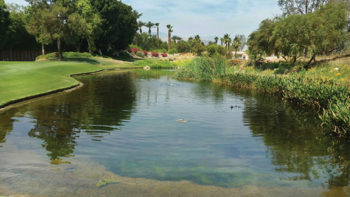
The living components of a lake or pond ecosystem, or biota, can serve as indicators for a healthy lake ecosystem. If your lake is in a healthy balance, it will be able to serve as a habitat and support biodiverse species. On the other hand, an overabundance of plants, animals and microbes can begin to get out of control if the balance is disrupted. For example, if dissolved oxygen levels begin to drop drastically, it will no longer be able to support certain species of fish, marine organisms and aquatic plants. Too much waterfowl can also impact surrounding plant species and exponentially increase nutrient intake in the body of water.
Age
Oligotrophic lakes are clear and deep, containing very low levels of nutrients and low primary production. It is characteristic of young lakes. Mesotrophic lakes contain some nutrients, organic accumulation and occasional algae. This is typically the age most lakes will fall into. Eutrophic lakes are nutrient-rich with high primary production and can be subject to frequent algal blooms. Other common characteristics include heavy accumulation of organic matter and low clarity. Eutrophic lakes, being the most degraded with age, usually tend to be the most problematic.
Environmental Factors
Major environmental factors that can affect the health of your lake include climate, temperature increases, precipitation and land use. More frequent droughts and shifting precipitation patterns lower water levels in lakes, leaving less water to dilute pollutants. Higher temperatures cause more frequent algal blooms and reduce dissolved oxygen levels, which have the potential to cause fish kills and render significant harm to the ecosystem as a whole.
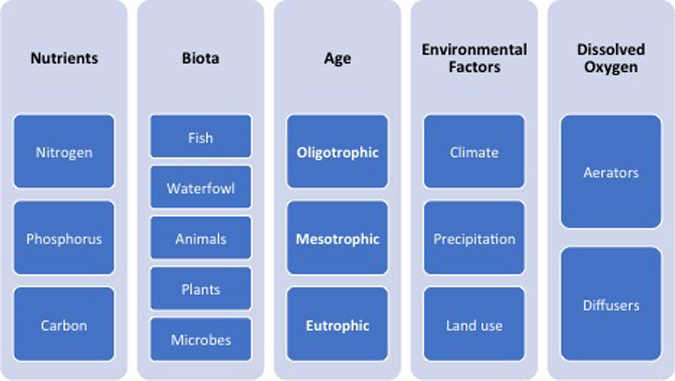
Dissolved Oxygen
Aquatic organisms require oxygen to breathe and survive. Dissolved-oxygen concentrations must be maintained above a certain threshold for fish and other species to perform respiration. Healthy systems include aerators, diffusers, fountains, waterfalls and other mechanisms to supplement natural agitation and increase dissolved-oxygen concentrations.
Tackling Issues
Issues are dependent on the water-quality expectations of property managers. Some managers do not mind algae and do not see this as an issue. For many esteemed golf course managers, on the other hand, the clean and healthy appearance of a lake or a pond is critical. The most common issues in many golf courses are algae overgrowth, foul odors, murky water and pests.
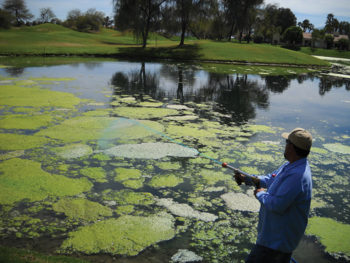
Other major issues worth avoiding include nutrient enrichment and eutrophication. As mentioned earlier, lakes become eutrophic when they receive excessive nutrient inputs like fertilizers, chemicals, grass clippings and feces. Nutrients are the most common limiting factor of primary production in aquatic ecosystems. When nutrient limitations are removed, plants and algae grow aggressively and uncontrollably.
There are all kinds of solutions; some work as promised, but none can be the solution by itself. The best approach is to start with the idea of restoring a balance by providing adequate circulation, managing nutrient levels and adjusting suspended solids with a program. The trick is not to create a new problem by overloading only one side of the equation.
A Five-Step Program
First, aeration is a process that promotes biological degradation of organic waste. There are two types. Passive is when waste is exposed to air, and active is when a mixing or bubbling device introduces the air. Benefits of aeration include algae reduction, fish health, water-quality improvement, odor reduction, muck-accumulation reduction and mosquito-population control.
Next, filtration is the removal of impurities from water to increase clarity and quality. Types of filters include sand filters, cartridge filters, biofilters and once-throughs.
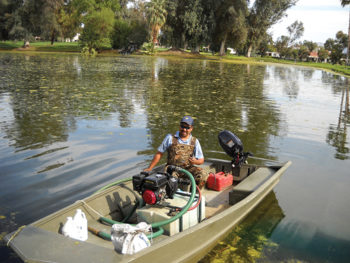
Step three is physical maintenance, which is needed at times for general cleanup and upkeep. Removal of aquatic weeds and algae can be achieved through manual labor or mechanical means. Conducting physical maintenance removes problem species directly from the site.
The fourth step is the implementation of plant and animal life to promote aesthetics and ecological balance. An example of achieving balance is to ensure that there are more foragers than predators in a lake.
Finally, chemical treatment can be highly effective for problematic species. In order to remove invasive plants or pests, one may resort to aquatic herbicides and algaecides. In order to achieve a natural balance, a promising cocktail of a pure liquid enzyme mixed with an algaecide would be a great solution. Enzymes have the vital role of not only breaking down complex waste, such as bottom pond sludge that has accumulated over time, but also enhancing natural bacteria growth. Bacteria will then consume the remaining organic waste.
The Bottom Line
Keep in mind that much more of the earth is covered in water than land. We need to remember to give all biotic aspects of the world the respect they are due. That’s what we professionals do every day. We aren’t cleaning lakes and reservoirs; we are managing a delicate balance between natural aquatic organisms and the aesthetic appearance of highly visible bodies of water within the golf courses. That’s our specialty. Don’t assume that one thing can resolve all problems, but be motivated by the challenge. You can have it all if you delegate lake and pond management to a knowledgeable person. Always remember: it’s nature with whom we are dealing.
When your pond gets hit with an unsightly pea-soup green appearance or starts to emit an odor, the answer won’t be a single fix-all. It will be a package of solutions working together to resolve the problem.
